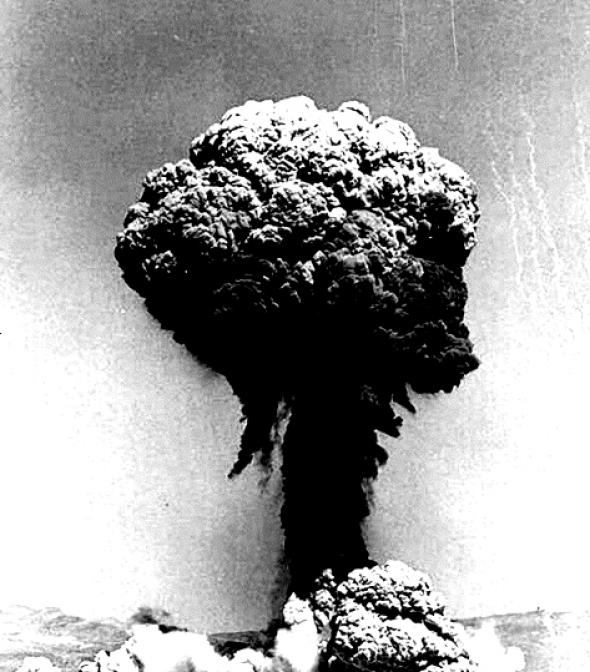Technological Kindergarten
Simon Ford appraises the destructive art of Gustav Metzger, focusing on the often overlooked early use of computer science in his work. Unrealised pieces such as Five Screens with Computer may have been part of the ‘false avantgarde’ of computer art, but did they prefigure some of the concerns of today’s digital art practice?
On 21 January 2003 a crowd of onlookers watched as the 77 year-old artist Gustav Metzger scurried through 100,000 newspapers piled up in the dark basement of T1&2 Artspace, a squatted building in Spitalfields, London. With the newspapers filled with reports on the coming war in Iraq, Metzger’s actions appeared especially charged. Here was a man who, in his own words, had dedicated his life ‘to the task of eliminating war and other social injustices.’[1]
Metzger was born on 10 April 1926 in Nuremberg. His Polish Jewish parents had immigrated to Germany just eight years before. In January 1939 they sent the 12-year-old Gustav, along with a brother, to England as part of the Refugee Children movement. It was just in time. Those members of his family that remained in Germany were subsequently murdered in the Nazi concentration camps. After a brief period living in a commune in Bristol, Metzger decided to become an artist. His studies took him to Cambridge, London, Antwerp, and then back to London where he studied at Borough Polytechnic School under David Bomberg. By this time his experience of fascism in Germany and the nuclear destruction of Hiroshima and Nagasaki had already provided the foundations for his life-long political commitment: ‘The atomic bomb is really the starting point of my own work. This is the point when I was an art student and I was very conscious that from now on everything was different, including art. From that point, I started to probe the limits of art, of what one could do and what one had to do in relation to society, in relation to helping society so that this couldn’t happen again.’[2]
Metzger’s commitment to the anti-nuclear movement soon became the most obvious manifestation of his opposition to Cold War nuclear proliferation, but it also informed his development of auto-destructive art. Announcing a new form of ‘public art for industrial societies’, Metzger’s first auto-destructive art manifesto appeared in November 1959.[3] His second manifesto, ‘Manifesto Auto-Destructive Art’, appeared in 1960. In it he described ‘man in Regent Street’ and ‘rockets’ and ‘nuclear weapons’ as auto-destructive, along with materials and processes such as acid, ballistics, cybernetics, electricity, explosives, feed-back, human energy, mass-production, nuclear energy, and radiation. Auto-destructive art transformed technology into public art and mirrored ‘the compulsive perfectionism of arms manufacture – polishing to destruction point.’[4]
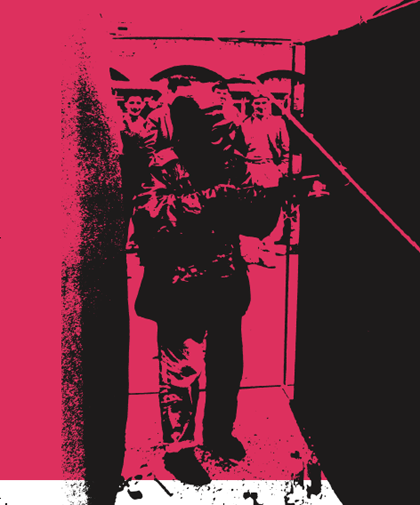
Fittingly, Pat Arrowsmith, Field Secretary for the Direct Action Committee Against Nuclear War, wrote one of the earliest reviews of Metzger’s work for Peace News: ‘I myself walked into London beside him at the end of last year’s Aldermaston March … [He also] stood up on a soap box to address the stall-holders of Watton market.’[5] Metzger’s activism led him to become a founder member of the Committee of 100, a group dedicated to non-violent civil disobedience. In September 1961 at Bow Street Magistrates Court, Metzger, along with other members of the Committee, refused to be bound over to keep the peace for a year. For this Metzger was imprisoned for a month along with other Committee members including Alex Comfort, Bertrand Russell, Arnold Wesker and Christopher Logue. At his trial he read out a prepared statement: ‘I came to this country from Germany when 12 years old, my parents being Polish Jews, and I am grateful for the Government for bringing me over. My parents disappeared in 1943 and I would have shared their fate. But the situation is now far more barbarous than Buchenwald, for there can be absolute obliteration at any moment. I have no other choice than to assert my right to live, and we have chosen, in this committee, a method of fighting which is the exact opposite of war – the principle of total non-violence.’[6]
In July 1961, just before his trial, Metzger organised a key auto-destructive event, an open-air demonstration at the South Bank in London. Armed with a spray gun filled with acid and dressed in combat clothing and a gasmask, he attacked three large sheets of nylon attached to a metal frame. The accompanying manifesto contained Metzger’s first mention of computers as a possible ingredient of auto-destructive art: ‘Auto-destructive art and auto-creative art aim at the integration of art with the advances of science and technology. The immediate objective is the creation, with the aid of computers, of works of art whose movements are programmed and include “self-regulation”. The spectator, by means of electronic devices can have a direct bearing on the action of these works. Auto-destructive art is an attack on capitalist values and the drive to nuclear annihilation.’[7]
It took another four years before Metzger provided a more detailed proposal to create an artwork that included a computer as an integral element.[8] Five Screens with Computer, he wrote, would consist of five walls or screens made of stainless steel, each 30 feet high, 40 feet long and two feet deep. They would be arranged about 25 feet apart in a central area between three high-rise tower blocks. Each wall would be composed of 10,000 uniform elements made of stainless steel, glass or plastic and be square, rectangular or hexagonal in shape. Each element would be individually ejected from the screen over a period of ten years until the screens literally fell to pieces.
Metzger still had to work out how the elements would be ejected but at this point he proposed the use of magnets and compressed air. The computer’s job was to control – according to a program devised by the artist – the sequence of these ejections. This program would take into account the quality of light and shade, the revolution of the earth, the various seasons, the weather and spectator participation via photo-electronic switches. Metzger claimed that the computer would link art, technology and society and only through its use could the artist ‘achieve forms and rhythms that correspond[ed] to his aims.’ Through the work Metzger aimed to re-channel the destructive potential of the computer: ‘Today, death is fed into, processed and administered by the computers.’ Unlike his acid on nylon paintings, the computer also provided an escape from connotations of expressionism and the fetishisation of the mark left by the artist’s hand. This huge sculpture, in such a prominent public space, would make a spectacle of destruction and in the process, Metzger hoped, would ‘initiate a series of controversies that can become a kind of mass-therapy as well as educational programme.’[9] Equally you could imagine some viewers, especially those living in the nearby tower blocks, reading the random ejections of the units as analogous to the lack of autonomy and control in their own lives. And, of course, the irony now is that it is the tower blocks themselves that are regularly demolished in celebratory and public spectacles of destruction and regeneration.
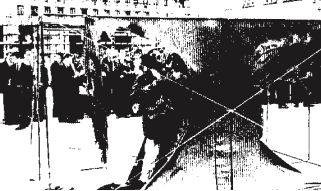
Metzger’s interest in computer art in 1965 coincided with a number of key events in its early history, most significantly the first computer art exhibitions at the Technische Hochschule in Stuttgart and the Howard Wise Gallery in New York. A year later IBM recruited its first artist-in-residence, John Whitney Sr., and the Museum of Modern Art purchased Charles Csuri’s computer-generated image Hummingbird.[10]
Metzger spent much of 1966 organising the Destruction In Art Symposium (DIAS) and much of 1967 dealing with its consequences[11], but he returned to the problematic of working with computers in 1968 for the exhibition ‘Cybernetic Serendipity: The Computer and the Arts.’[12] Curated by Jasia Reichardt, it was the first exhibition in Britain to demonstrate the creative potential of computers. Metzger’s participation, however, did not prevent him severely criticising the exhibition. His focus remained on issues of social responsibility for both the artists and scientists involved in the new technology and he countered those who advocated the utopian possibilities of the coming computer age with sobering details of its origins in military research. ‘Cybernetic Serendipity’, he complained, provided ‘a perfectly adequate demonstration of the reactionary potential of art and technology. No end of information on computers composing haiku – no hint that computers dominate modern war; that they are becoming the most totalitarian tools ever used on society. We are faced by this prospect – whilst more and more scientists are investigating the threats that science and technology pose for society, artists are being led into a technological kindergarten.’[13] Metzger’s contribution to the exhibition took the form of a description of his latest version of Five Screens with Computer. Slight modifications included increasing the distance between the screens from 25 feet to 30 feet and also the introduction of a festive element when suggesting that the ‘frequency of ejections on holidays may reach 600 a day.’[14]
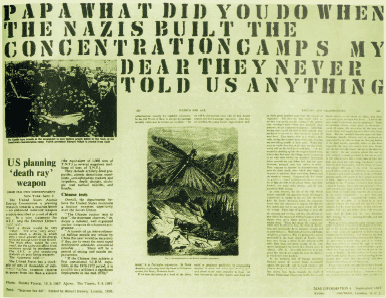
The work’s most developed description came a year later during ‘Event One’ at the Royal College of Art (29-30 March 1969). The most significant modification saw the number of elements in each screen reduced from 10,000 down to 1200. Metzger also provided more details on how the individual elements would operate: ‘These elements can be moved forwards or backwards within a frame at controlled speeds, and will finally be ejected at various controlled speeds, reaching a maximum distance of 30ft.’ Metzger utilised the computer in three key areas: design, operation and recording:
DESIGN
Since all the decisions on the activity of the screens will be made before production begins it is necessary to have the most complete understanding of the work’s potential at the design stage. A computer allied to graphic output will be used to plot the numerous possibilities for moving and ejecting elements, and for visualizing the possible shapes of the screens in transformation. 55% of the elements will be ejected on a pre-determined programme. The rest (including one entire screen) will be ejected in a random manner. These random ejections will be sparked off by intense sun or electric light, or by the assembly of people above a certain number in the vicinity of a screen. Random ejections are subject to a variety of controls such as structural considerations, and will be co-ordinated with the overall programme.
OPERATION
A computer will be in general control of the electro/mechanical activity of the sculpture – continuous adjustments (on-line) will be necessary. The computer will also direct peripheral activity such as the raising of the glass wall surrounding the site before ejections can take place.
RECORDING
The computer will be used to print out and draw the day-by-day development of the screens. This will be necessary to check on operational, structural, and safety factors, and will be an aid to maintenance activities. This graphic output, along with photographs and films, will be preserved as part of the documentation on the work.[15]
In another text from this period Metzger stated that when not being employed by the ejections the computer could be used by the inhabitants of the flats: ‘By means of telephone lines it can serve as a local convenient library for the inhabitants.’[16]
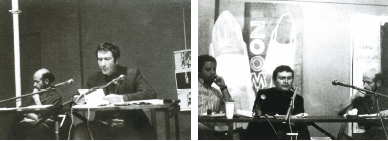
Metzger’s description of the project offered little explanation of how the artwork’s immediate audience might be consulted or invited to interact with the sculpture. As Metzger clearly stated in the ‘Event One’ text ‘all the decisions on the activity of the screens would be made before production begins.’ This point is significant because, if realised, such a sculpture would almost certainly have attracted great resentment from its local audience. Not only would there have been extensive and expensive construction and maintenance work, there would also have been considerable noise from the explosive ejection of the units, which in themselves would have posed a serious health risk (only belatedly allayed by Metzger’s suggestion that a retractable glass wall should surround the site, protecting both the public from the sculpture and the sculpture from the public).
It was probably these and many other pragmatic concerns that stopped Metzger from taking his proposals any further. After ‘Event One’ his engagement with computers and art became increasingly bound up with a new organisation, the Computer Arts Society (CAS), set up ‘to encourage the creative use of computers in the arts and allow the exchange of information in this area.’ The idea for the Society was first mooted on the afternoon of 7 August 1968 at an informal session on Computers and Music at the IFIP Congress in Edinburgh.[17] Alan Sutcliffe, then Head of ICL’s Programme Research Unit, became its Chairman, R.J. Lansdown, Architectural Partner of Ian Fraser & Associates, became its Secretary, and Metzger volunteered to be the founding editor of its newsletter, PAGE: Bulletin of the Computer Arts Society. The Society initially held its meetings in rooms donated by the British Computer Society at 29 Portland Place, London, but by June 1971 it had moved into its own permanent space, two rooms on the second floor of The Dairy in Camden, a large complex of artists’ studios run by SPACE.
In 1971 the membership of CAS consisted of 500 enthusiasts worldwide. At this time access to computers was severely limited, with most being owned by scientific and military institutions. Artistic projects formed only a small and often informal element of their operation, so as part of the Society’s brief to publicise and lobby for artistic projects, it hosted events such as the Computer Art session at Computer Graphics 70.[18] Advertised as ‘More than a symposium – more than an exhibition – an international meeting of minds’ the conference boasted key representatives from the industrial-military complex: General Motors, Lockheed Georgia, Mobil Oil Corporation, Royal Navy, Ford Motor Company, Space Flight Center, Boeing, Sperry Rand and Unilever.’ At the conference Metzger presented a paper on ‘New Ideas in Plotter Design Construction and Output’ and two months later, on 24 June, he gave another paper, this time at the British Computer Society, entitled ‘Computers and Sculpture’.
Such activities formed part of Metzger’s plan to ‘seek an alliance with the most advanced research in natural and artificial intelligence.’[19] It also complemented his active membership of the British Society for Social Responsibility in Science,[20] and culminated in a two-page essay for PAGE, where he listed every article that had appeared in the main professional journals of the day (Computers and Automation and Communications of the Association for Computing Machinery) that exposed links between computers and weapons of mass destruction. For Metzger these references and selected quotations also provided ample proof that the development of computers and armaments were both closely integrated with the capitalist economy.[21]
Metzger’s involvement with PAGE ended with issue 26 in November 1972, when the bulletin announced he was ‘too busy’ with other projects to continue.[22] These projects included his participation in 3 Life Situations at Gallery House, his assistance in founding the Artists’ Union and his preparations for the Art Strike, 1977-1980.[23] He published no further plans for Five Screens with Computer and for most of the 1980s kept an extremely low profile, only returning to public life in the 1990s with proposals for artworks that focused increasingly on environmental issues. More recently curators have included his work in important historical group shows, such as Life/Live, Out of Actions and Live in Your Head[24] and a major retrospective of his work took place in 1998 at Oxford’s Museum of Modern Art.[25] To date, though, most attention has continued to focus on Metzger’s spectacular acts of destruction with little attention being paid to his brief engagement with computer science.
In retrospect Five Screens with Computer appeared at the height of what became the first false dawn of computer arts. It would take at least another two decades, the development of personal computers and the growth of the internet, before digital art once again achieved even nominal artworld status. Thirty-odd years on, however, Metzger’s critique of the dubious techno-utopianism of some computer artists and his inconvenient pointing at the origin of much computer technology in the military and state security sectors, still holds true. Also sadly prescient is his non-ironic assertion in 1971 that in terms of computer art, at least, ‘the real avant-garde was the army’.[26]
[1] Gustav Metzger, ‘The Artist in the Face of Social Collapse’ in Melanie Keen (ed.) Frequencies: Investigations into Culture, History and Technology. London: inIVA, 1998, p. 82[2] Metzger in Kristine Stiles, The Destruction In Art Symposium (DIAS): The Radical Cultural Project of Event-Structured Live Art. Unpublished PhD Thesis. Berkeley: University of California, 1987, p. 74[3] Gustav Metzger, ‘Auto-Destructive Art’, London, 4 November 1959. The manifesto accompanied an exhibition, at 14 Monmouth Street, of discarded cardboard packaging that Metzger discovered on Fulham Road[4] Gustav Metzger, ‘Manifesto of Auto-Destructive Art’, London, 10 March 1960[5] Pat Arrowsmith, ‘Auto-Destructive Art’, Peace News, 22 July 1960, p. 11. The review was of a demonstration that took place at the Temple Gallery, London, on 22 June 1960[6] Gustav Metzger in ‘Quotes from Bow Street’, Peace News, 15 September 1961, p. 7[7] Gustav Metzger, ‘Auto-Destructive Art, Machine Art, Auto-Creative Art’, London, 23 June 1961[8] Gustav Metzger, Auto-destructive Art: A Talk at the Architectural Association. London: Destruction / Creation, 1965. In the text Metzger acknowledged the assistance of Beverly Rowe, then Chief applications programmer at the University of London Computer Centre. She later became a founding member of the Computer Arts Society[9] Ibid, p. [10] See Charlie Gere, Digital Culture, London: Reaktion Books, 2002, p. 100. Metzger was also well aware of the work of Roy Ascott and shared his interest in cybernetics. In December 1962 Ascott invited Metzger to give a lecture on auto-destructive art at Ealing College of Art. In the audience was Pete Townshend who later took some of Metzger’s ideas into the realm of rock music with his spectacular auto-destructive performances with The Who[11] DIAS ran from 31 August – 30 September 1966. After the performance by Hermann Nitsch at St Brides Institute on Fleet Street, on 15 September 1966, Metzger and his fellow organiser John Sharkey were charged with ‘having unlawfully caused to be shown a lewd and indecent exhibition.’ On [19] July 1967 the court found Metzger guilty and he accepted a £100 fine rather than spend four months in jail[12] The exhibition was held at the Institute of Contemporary Arts, London, 2 August – 20 October 1968. See also: Jasia Reichardt, (ed.). Cybernetics, Art and Ideas. London: Studio Vista, 197113 Gustav Metzger, ‘Automata in History: Part 1’, Studio International, March 1969, pp. 107-109[14] Gustav Metzger, ‘Five Screens with Computer’ in Jasia Reichardt (ed.) Cybernetic Serendipity: The Computer and The Arts. London: Studio International, 1968, p. 31[15] Gustav Metzger, ‘Five Screens with Computer (1963-69)’: in Event One, London: Computer Art Society, 1969, unpaginated. Metzger accompanied the text with a scematic drawing of ‘the development of one screen (no. 3) in the first three years of its activity.’ The drawing is credited to Mr. D.E. Evans, of the Computer Unit, Imperial College, London and was produced on an ‘IBM 7094 11 (32K memory) with CALCOMP plotter.’[16] Gustav Metzger, speech at the conference Computers and Visual Research, Zagreb, 1969, transcript in Bit International, no. 7, 1971. As a further sign of Metzger’s commitment to computer art at this time he was also working on the translation into English of Herbert Werner Franke’s seminal work Computer Graphics, Computer Art published by Phaidon in 1971[17] Mission statement and information from PAGE, no. 3, June 196918 Hosted by Brunel University, Uxbridge, Middlesex, 14-16 April 1970. Information from conference programme: Computer Graphics 70, Uxbridge, 1970[19] Gordon Hyde, Jonathan Benthall, and Gustav Metzger. ‘Zagreb Manifesto’, Studio International, June 1969, p. 259[20] Formed in April 1969[21] Gustav Metzger, ‘Social Responsibility and the Computer Professional, Part 1’, PAGE, no. 11, October 1970. There was no part 2[22] Anon, PAGE, no. 26, November 1972[23] Metzger’s announcement can be found in Art into Society – Society into Art. London: ICA, 1974, p. 74[24] Life/Live, MusÈe d’Art Moderne de la Ville de Paris, 5 October – 5 January 1997; Out of Actions: Between Performance and the Object 1949-1979, The Geffen Contemporary at the Museum of Contemporary Art, Los Angeles, 8 February – 10 May 1998 and travelling; and Live in Your Head: Concept and Experiment in Britain, 1965-75, Whitechapel Art Gallery, 4 February – 2 April 2000[25] See the catalogue: Gustav Metzger, Kerry Brougher, and Astrid Bowron, (eds). Oxford: Museum of Modern Art Oxford, 1998[26] Citing as evidence the success – in the first computer art competition organised by Computers and Automation in 1963 – of the US Army Ballistic Missile Research Laboratory. See Metzger, op cit, Bit International, no. 7, 1971. According to Charlie Gere the US Army also won second place. See Gere, op cit, 2002, p. 100
Simon Ford <fordmobile AT tiscali.co.uk> is the author of Hip Priest: the Story of Mark E. Smith and the Fall (Quartet, 2003)
Mute Books Orders
For Mute Books distribution contact Anagram Books
contact@anagrambooks.com
For online purchases visit anagrambooks.com


